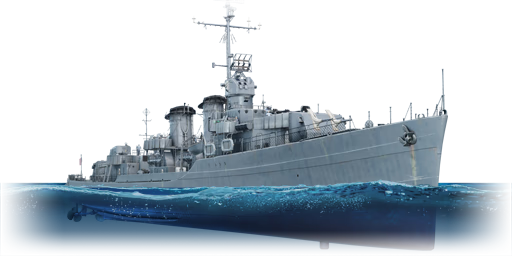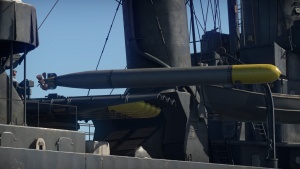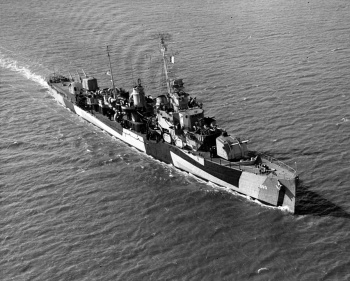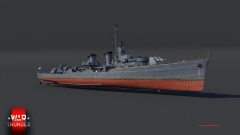USS Phelps
Contents
Description
The Porter-class, USS Phelps (DD-360), 1944 is a gift rank American destroyer
with a battle rating of (AB), (RB), and (SB). It was introduced during Update 1.95 "Northern Wind" as a reward for Season: Attack from the Sea.
General info
Survivability and armour
Talk about the vehicle's armour. Note the most well-defended and most vulnerable zones, e.g. the ammo magazine. Evaluate the composition of components and assemblies responsible for movement and manoeuvrability. Evaluate the survivability of the primary and secondary armaments separately. Don't forget to mention the size of the crew, which plays an important role in fleet mechanics. Save tips on preserving survivability for the "Usage in battles" section. If necessary, use a graphical template to show the most well-protected or most vulnerable points in the armour.
Mobility
Write about the ship's mobility. Evaluate its power and manoeuvrability, rudder rerouting speed, stopping speed at full tilt, with its maximum forward and reverse speed.
Armament
Primary armament
Provide information about the characteristics of the primary armament. Evaluate their efficacy in battle based on their reload speed, ballistics and the capacity of their shells. Add a link to the main article about the weapon: {{main|Weapon name (calibre)}}. Broadly describe the ammunition available for the primary armament, and provide recommendations on how to use it and which ammunition to choose.
Secondary armament
Some ships are fitted with weapons of various calibres. Secondary armaments are defined as weapons chosen with the control Select secondary weapon. Evaluate the secondary armaments and give advice on how to use them. Describe the ammunition available for the secondary armament. Provide recommendations on how to use them and which ammunition to choose. Remember that any anti-air armament, even heavy calibre weapons, belong in the next section. If there is no secondary armament, remove this section.
Anti-aircraft armament
An important part of the ship's armament responsible for air defence. Anti-aircraft armament is defined by the weapon chosen with the control Select anti-aircraft weapons. Talk about the ship's anti-air cannons and machine guns, the number of guns and their positions, their effective range, and about their overall effectiveness – including against surface targets. If there are no anti-aircraft armaments, remove this section.
Torpedo armament
Torpedoes launchers are standard equipment on many ships and boats. Torpedoes are a significant means of defeating an opponent. Evaluate the position of the torpedo launchers, discuss the ammunition available, firing specifics such as dead zones, features of the torpedoes themselves, etc. If there is no torpedo armament, remove this section.
Special armament
Depth charges, mines, rocket launchers and missiles are also effective in skilled hands and can take an off-guard opponent by surprise. Evaluate the ammunition of this type of armament and rate its performance in combat. If there are no special armaments, remove this section.
Usage in battles
Describe the technique of using this ship, the characteristics of her use in a team and tips on strategy. Abstain from writing an entire guide – don't try to provide a single point of view, but give the reader food for thought. Talk about the most dangerous opponents for this vehicle and provide recommendations on fighting them. If necessary, note the specifics of playing with this vehicle in various modes (AB, RB, SB).
Modules
| Tier | Seakeeping | Unsinkability | Firepower | |||
|---|---|---|---|---|---|---|
| I | Dry-Docking | Tool Set | 5 inch Common Mk.32 | 40 mm HE clips | Anti-Air Armament Targeting | |
| II | Rudder Replacement | Fire Protection System | Smokescreen | 5 inch SP Common Mk.46 | 40 mm AP clips | Auxiliary Armament Targeting |
| III | Propeller Replacement | Shrapnel Protection | Ventilation | 5 inch AAVT Mk.31 | Improved Rangefinder | Primary Armament Targeting |
| IV | Engine Maintenance | New Pumps | Ammo Wetting | Torpedo Mode | Bomb mortar | |
| This is a premium vehicle: all modifications are unlocked on purchase | ||||||
Pros and cons
Summarise and briefly evaluate the vehicle in terms of its characteristics and combat effectiveness. Mark its pros and cons in the bulleted list. Try not to use more than 6 points for each of the characteristics. Avoid using categorical definitions such as "bad", "good" and the like - use substitutions with softer forms such as "inadequate" and "effective".
Pros:
Cons:
History
USS Phelps (DD-360) was a destroyer leader of the Porter class. She was one of the most active American destroyers of the Second World War, earning 12 battle stars as the Flagship of Destroyer Squadron 1. Following her commissioning in 1936, she served in peacetime duties with the Pacific fleet, and was present at the Pearl Harbour Attack where she shot down an enemy plane. She then participated in the Battle of the Coral Sea, where she scuttled the abandoned carrier Lexington with five torpedoes. She served as an escort during the Battle of Midway, participated in the Marshall Islands campaign and spent the last part of the war as a convoy escort in the Atlantic. She was decommissioned and scrapped by 1947.[1]
Design and construction
The Phelps, named after Rear Admiral Thomas Stowell Phelps, was one of eight Porter-class destroyers used by the US Navy. The ships displaced 1,850 tons, exactly matching the 1,850-ton destroyer weight limitation of the London Naval Treaty. However, she typically displaced over 2,000 tons on combat missions and up to 2,663 tons full load. As a destroyer-leader, the Phelps carried eight 5-inch (127 mm) single-purpose guns on four twin turrets;[2] she was later refitted to carry two 5-inch dual-purpose twin turrets and a single five-inch DP turret at the rear. Her anti-aircraft armament was initially sparse, but was upgraded through the course of the war. Phelps also carried eight 533 mm torpedo tubes in two quad-mounts. She could make a top speed of 37 knots (69 km/h) and had a crew complement of 276.[2]
The Phelps was laid down on January 2nd 1934, and was launched on July 18th 1935. Following the completion of construction, she was commissioned on February 26th 1936.[1][2]
Operational history
After her commissioning, the Phelps escorted the cruisers Indianapolis and Chester with President Franklin D. Roosevelt to the Inter-American peace conference in Buenos Aires. She was then headquartered in the Pacific as the flagship of the First Destroyer Squadron. She was present at the Pearl Harbour attack and claimed one aircraft shot down. She was later assigned to escort Task Force 11, with the aircraft carrier Lexington, at the Battle of the Coral Sea. She also performed the less fortunate duty of finishing off the crippled Lexington using torpedoes after the carrier was hit by numerous Japanese bombs.[1][2]
Phelps served as an escort for the American carrier force at the Battle of Midway, where she took no damage. She participated in the landings at Guadalcanal and the ones at Attu, Alaska, where she provided gunfire support to invasion troops. She returned to the southern Pacific to serve as a gunship at the Marshall Islands campaign, where she bombarded Kwajalein and Eniwetok.[1] In June of 1944, she was part of the bombardment force at Saipan, shelling the island in preparation for American landings. In late 1944, she steamed through the Panama canal and served her final duty as a convoy escort in the Atlantic; she sailed three times with convoys bound for the Mediterranean. Following the War's end, she was decommissioned, and was scrapped in 1947. Phelps received 12 battle stars for her service during the war.[1][2]
Media
See also
Links to articles on the War Thunder Wiki that you think will be useful for the reader, for example:
- reference to the series of the ship;
- links to approximate analogues of other nations and research trees.
External links
References
Works Cited
- Destroyer History Foundation. (2000). USS Phelps, DD 360. Retrieved November 19, 2020, from http://www.destroyerhistory.org/goldplater/ussphelps/
- Willishaw, F. (1996). USS PHELPS (DD-360). Retrieved November 19, 2020, from http://www.navsource.org/archives/05/360.htm
| Bethlehem Steel Corporation | |
|---|---|
| Gun Destroyers (DD) | |
| Porter-class | USS Phelps · USS Moffett |
| Fletcher-class | USS Cowell |
| Destroyer Leaders (DL) | |
| Mitscher-class | USS Wilkinson |
| Cruiser, Light (CL) | |
| Omaha-class | USS Raleigh · USS Detroit |
| Heavy Cruisers (CA) | |
| Northampton-class | USS Northampton |
| Portland-class | USS Portland |
| Baltimore-class | USS Baltimore · USS Pittsburgh |
| Des Moines-class | USS Des Moines |
| USA destroyers | |
|---|---|
| Clemson-class | USS Welborn C. Wood · USS Barker · USS Litchfield |
| Farragut-class | USS Aylwin |
| Bagley-class | USS Bagley |
| Porter-class | USS Porter · USS Phelps · USS Moffett |
| Somers-class | USS Somers · USS Davis |
| Fletcher-class | USS Fletcher · USS Bennion · USS Cowell |
| Allen M. Sumner-class | USS Sumner |
| Gearing-class | USS Gearing · USS Frank Knox |
| Mitscher-class | USS Mitscher · USS Wilkinson |
| USA premium ships | |
|---|---|
| Motor torpedo boats | PT-3 · PT-109 · PT-174 · Thunderbolt (PT-556) · PT-658 · PT-811 |
| Motor gun boats | LCM(6) Zippo · USS Douglas · USS Flagstaff |
| Sub-chasers | Carmi (PC-466) |
| Destroyers | USS Welborn C. Wood · USS Wilkinson · USS Bennion · USS Cowell · USS Davis · USS Moffett · USS Phelps · USS Frank Knox |
| Light cruisers | USS Detroit · USS Helena |
| Heavy cruisers | USS Des Moines |
| Battleships | USS Arkansas |









